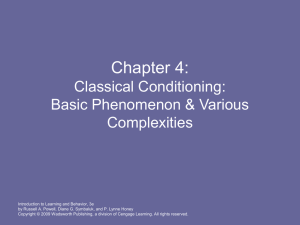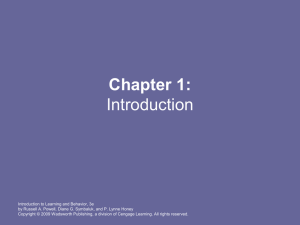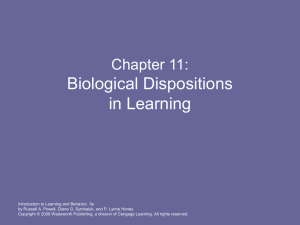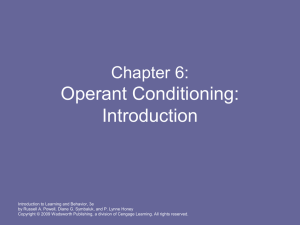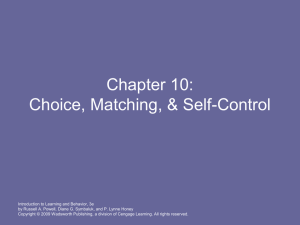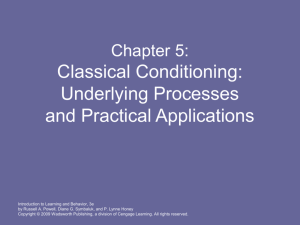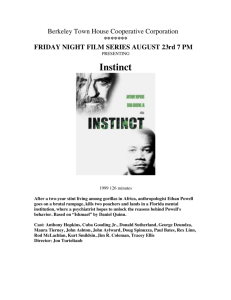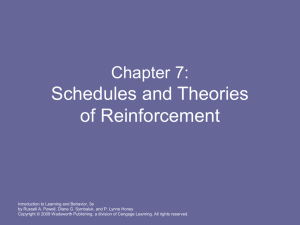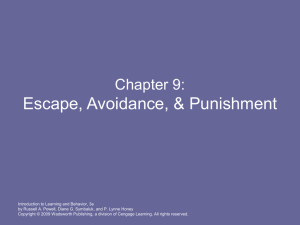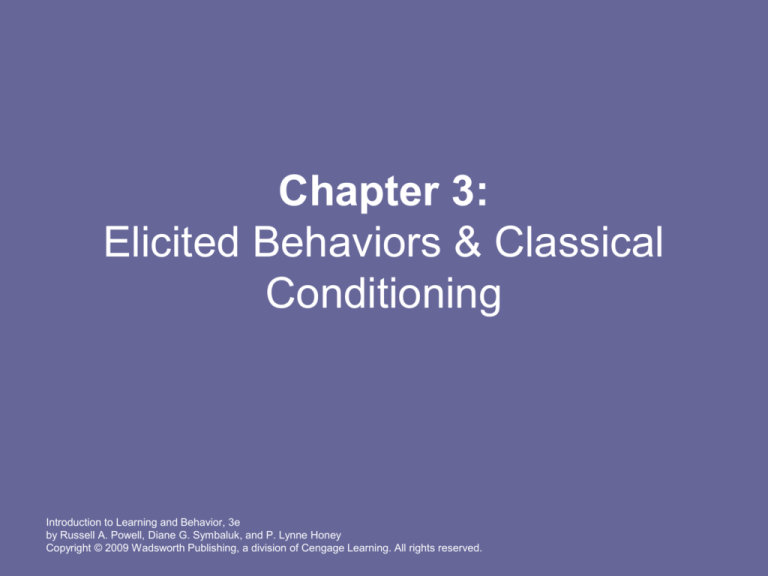
Chapter 3:
Elicited Behaviors & Classical
Conditioning
Introduction to Learning and Behavior, 3e
by Russell A. Powell, Diane G. Symbaluk, and P. Lynne Honey
Copyright © 2009 Wadsworth Publishing, a division of Cengage Learning. All rights reserved.
Elicited Behaviors
• Classical Conditioning involves elicited
behaviors.
• What is an elicited behavior?
– a behavior that is “drawn out” of an organism
by the presentation of a stimulus
– a behavior that is automatic and involuntary
– examples: sneezing, startling, salivating
Introduction to Learning and Behavior, 3e
by Russell A. Powell, Diane G. Symbaluk, and P. Lynne Honey
Copyright © 2009 Wadsworth Publishing, a division of Cengage Learning. All rights reserved.
Reflexes
• Basic form of elicited behavior
• Defined as “a relatively simple, automatic
response to a stimulus”
• Reflexes are closely tied to survival.
• Examples: startle response, orienting
response, flexion response
Introduction to Learning and Behavior, 3e
by Russell A. Powell, Diane G. Symbaluk, and P. Lynne Honey
Copyright © 2009 Wadsworth Publishing, a division of Cengage Learning. All rights reserved.
Reflex Arc
• Simple reflexes are activated through a
reflex arc.
• Defined as “a neural structure that
underlies many reflexes and consists of a
sensory neuron, an interneuron, and a
motor neuron.”
• Reflex arcs allow us to respond much
quicker to our environment.
Introduction to Learning and Behavior, 3e
by Russell A. Powell, Diane G. Symbaluk, and P. Lynne Honey
Copyright © 2009 Wadsworth Publishing, a division of Cengage Learning. All rights reserved.
Fixed Action Patterns
• Similar to, but more complex than, reflexes
• Defined as “a fixed sequence of responses
elicited by a specific stimulus”
• Examples:
– Cat scratching the ground around urine and
feces
– Dog preparing to play
Introduction to Learning and Behavior, 3e
by Russell A. Powell, Diane G. Symbaluk, and P. Lynne Honey
Copyright © 2009 Wadsworth Publishing, a division of Cengage Learning. All rights reserved.
Sign Stimulus
• Stimulus that sets the fixed action pattern
into motion
• Elicits a specific sequence of behaviors
• Examples:
– A Betta’s aggressive behaviors
– A male stickleback’s aggressive behaviors
Introduction to Learning and Behavior, 3e
by Russell A. Powell, Diane G. Symbaluk, and P. Lynne Honey
Copyright © 2009 Wadsworth Publishing, a division of Cengage Learning. All rights reserved.
Species-Specific Behaviors
• Fixed action patterns tend to be unique to
each species.
• They are often adaptive responses
evolved to help the species survive in the
environment.
• However, large changes in the
environment may render the pattern
useless or even harmful.
Introduction to Learning and Behavior, 3e
by Russell A. Powell, Diane G. Symbaluk, and P. Lynne Honey
Copyright © 2009 Wadsworth Publishing, a division of Cengage Learning. All rights reserved.
Mechanisms of Learning
• Habituation & sensitization tend to be
seen across species.
• These processes probably have
tremendous survival advantages.
• They help us sort information in our
environment into two basic categories:
currently relevant and currently irrelevant
(Eisenstein, Eisenstein, & Smith, 2001).
Introduction to Learning and Behavior, 3e
by Russell A. Powell, Diane G. Symbaluk, and P. Lynne Honey
Copyright © 2009 Wadsworth Publishing, a division of Cengage Learning. All rights reserved.
Habituation
• We tend to habituate to stimuli that are currently
irrelevant and low-intensity.
• Defined as “a decrease in the strength of an
elicited behavior following repeated
presentations of the eliciting stimulus”
• The first time the stimulus is present, the
response will probably be most intense. Then it
will gradually decrease.
• Examples: ticking of a clock, noise of traffic,
consistent drone of music from neighbor’s house
Introduction to Learning and Behavior, 3e
by Russell A. Powell, Diane G. Symbaluk, and P. Lynne Honey
Copyright © 2009 Wadsworth Publishing, a division of Cengage Learning. All rights reserved.
Dishabituation
• Defined as “the reappearance of a
habituated response following the
presentation of a seemingly irrelevant
novel stimulus”
• Example: a couple makes love in a novel
hotel room to rekindle their romance
Introduction to Learning and Behavior, 3e
by Russell A. Powell, Diane G. Symbaluk, and P. Lynne Honey
Copyright © 2009 Wadsworth Publishing, a division of Cengage Learning. All rights reserved.
Sensitization
• We tend to become sensitive to stimuli that are
extremely irrelevant and high-intensity.
• Defined as “an increase in the strength of an
elicited behavior following repeated
presentations of the eliciting stimulus”
• Unlike Habituation, Sensitization often
generalizes to other stimuli.
• Examples: war veterans’ responses to exploding
artillery shells and subsequent startling sounds
Introduction to Learning and Behavior, 3e
by Russell A. Powell, Diane G. Symbaluk, and P. Lynne Honey
Copyright © 2009 Wadsworth Publishing, a division of Cengage Learning. All rights reserved.
What happens when the stimulus is
of intermediate intensity?
• A stimulus of intermediate intensity often
results in an initial period of sensitization
followed by habituation.
• Example: visiting a shooting range
Introduction to Learning and Behavior, 3e
by Russell A. Powell, Diane G. Symbaluk, and P. Lynne Honey
Copyright © 2009 Wadsworth Publishing, a division of Cengage Learning. All rights reserved.
Evolutionary Perspective
• It makes sense to become sensitized to some
stimuli and habituated to others.
• Example:
– habituated to pressure of sitting in chair, but
sensitized to the caress of a lover – associated with
possible reproductive opportunities
• We don’t always get it right!
• Sometimes we become sensitized to harmless
stimuli and habituated to dangerous stimuli.
Introduction to Learning and Behavior, 3e
by Russell A. Powell, Diane G. Symbaluk, and P. Lynne Honey
Copyright © 2009 Wadsworth Publishing, a division of Cengage Learning. All rights reserved.
Opposing Reactivity
• Habituation and sensitization represent two
opposing tendencies of reactivity: strong versus
weak.
• Emotional responses can also oppose each
other.
• Example: lottery ticket, dog’s reaction to being
shocked
• Both events elicited a strong emotional
response; but when the event was withdrawn, an
opposite response was elicited and then
gradually disappeared.
Introduction to Learning and Behavior, 3e
by Russell A. Powell, Diane G. Symbaluk, and P. Lynne Honey
Copyright © 2009 Wadsworth Publishing, a division of Cengage Learning. All rights reserved.
Opponent-Process Theory of
Emotions
• Explains the aftereffects of strong
emotions.
• An emotional event elicits two competing
processes:
– an a-process (or primary process) that is
directly elicited by the event, and
– a b-process (or opponent process) that is
elicited by the a-process and serves to
counteract the a-process.
Introduction to Learning and Behavior, 3e
by Russell A. Powell, Diane G. Symbaluk, and P. Lynne Honey
Copyright © 2009 Wadsworth Publishing, a division of Cengage Learning. All rights reserved.
Dog’s Response to Shock
Introduction to Learning and Behavior, 3e
by Russell A. Powell, Diane G. Symbaluk, and P. Lynne Honey
Copyright © 2009 Wadsworth Publishing, a division of Cengage Learning. All rights reserved.
The A-Process
• correlates closely with the presence of the
emotional event
• When the shock is presented, heart rate
immediately increases; when the shock is
removed, heart rate immediately
decreases.
Introduction to Learning and Behavior, 3e
by Russell A. Powell, Diane G. Symbaluk, and P. Lynne Honey
Copyright © 2009 Wadsworth Publishing, a division of Cengage Learning. All rights reserved.
The B-Process
• is slow to increase and slow to decrease.
• Slowly the b-process begins to moderate
the a-process, causing a slight decrease in
heart rate before stabilizing.
• When the shock is removed, the a-process
immediately disappears; but the b-process
only slowly declines.
Introduction to Learning and Behavior, 3e
by Russell A. Powell, Diane G. Symbaluk, and P. Lynne Honey
Copyright © 2009 Wadsworth Publishing, a division of Cengage Learning. All rights reserved.
What happens when the dog is
shocked repeatedly?
• With repeated presentations of the
emotional event, the b-process increases
in both strength and duration.
• The increase in heart rate during each
shock becomes less and less extreme.
• Each time the shock is turned off, the
dog’s heart rate plunges more and more
deeply and takes increasingly longer to
return to normal.
Introduction to Learning and Behavior, 3e
by Russell A. Powell, Diane G. Symbaluk, and P. Lynne Honey
Copyright © 2009 Wadsworth Publishing, a division of Cengage Learning. All rights reserved.
Additional Examples
1. Military parachutists became less and
less terrified with repeated jumps and
became more and more elated following
each jump.
2. People in abusive relationships
sometimes have great difficulty leaving
because they become hooked on the
pleasure that occurs during periods of
forgiveness.
Introduction to Learning and Behavior, 3e
by Russell A. Powell, Diane G. Symbaluk, and P. Lynne Honey
Copyright © 2009 Wadsworth Publishing, a division of Cengage Learning. All rights reserved.
Learning –
Our survival depends on it!
• Our environment changes constantly and is filled with a
variety of stimuli.
• We need a mechanism by which we can adjust our
behavior to changing conditions.
• Biological or evolutionary change is too slow.
• We need a quick way to modify our behavioral potential
as a function of what we have experienced.
• Learning enables us to acquire some initial reactions to
the environment, and also permits these reactions to
change with changing circumstances.
Introduction to Learning and Behavior, 3e
by Russell A. Powell, Diane G. Symbaluk, and P. Lynne Honey
Copyright © 2009 Wadsworth Publishing, a division of Cengage Learning. All rights reserved.
Learning –
Our survival depends on it!
Continued…
• Our survival depends on our ability to learn
relationships among environmental
circumstance, so that we can anticipate
environmental events and react appropriately
and, sometimes, quickly to environmental
conditions.
• The ability to relate events to each other allows
us to better anticipate the future, thereby greatly
facilitating our chances of surviving.
Introduction to Learning and Behavior, 3e
by Russell A. Powell, Diane G. Symbaluk, and P. Lynne Honey
Copyright © 2009 Wadsworth Publishing, a division of Cengage Learning. All rights reserved.
Classical Conditioning
• One mechanism for learning
• Also called Pavlovian or respondent conditioning
• One stimulus that does not elicit a response is
associated with a second stimulus that does.
• As a result, the first stimulus also comes to elicit
a response.
Introduction to Learning and Behavior, 3e
by Russell A. Powell, Diane G. Symbaluk, and P. Lynne Honey
Copyright © 2009 Wadsworth Publishing, a division of Cengage Learning. All rights reserved.
Pavlov’s Discovery
• Ivan P. Pavlov (1849–1936)
• a Russian physiologist
• generally credited with the first systematic
investigations into classical conditioning
• investigated salivation, the initial step in
the digestive process
• found that salivation could be initiated with
“psychic” factors
Introduction to Learning and Behavior, 3e
by Russell A. Powell, Diane G. Symbaluk, and P. Lynne Honey
Copyright © 2009 Wadsworth Publishing, a division of Cengage Learning. All rights reserved.
Pavlov’s Basic Procedures of
Classical Conditioning
• Purpose: to train a dog to salivate to the
sound of a metronome.
• The dog was restrained in a harness, and
a tube was inserted into an incision that
had been made in its cheek.
• The saliva would run down the tube into a
container where it could be precisely
measured.
Introduction to Learning and Behavior, 3e
by Russell A. Powell, Diane G. Symbaluk, and P. Lynne Honey
Copyright © 2009 Wadsworth Publishing, a division of Cengage Learning. All rights reserved.
Unconditioned Stimulus (US)
• Defined as “a stimulus that naturally elicits
a response.”
• The food is called an unconditioned
stimulus (US).
• The dog did not have to learn to respond
to the food.
Introduction to Learning and Behavior, 3e
by Russell A. Powell, Diane G. Symbaluk, and P. Lynne Honey
Copyright © 2009 Wadsworth Publishing, a division of Cengage Learning. All rights reserved.
Unconditioned Response (UR)
• Defined as “the the response that is
naturally elicited by the US”
• Before conditioning, the dogs would
automatically salivate in response to the
taste of food.
• Because salivation to food occurs naturally
and does not require prior training
(conditioning), it is called an unconditioned
response (UR).
Introduction to Learning and Behavior, 3e
by Russell A. Powell, Diane G. Symbaluk, and P. Lynne Honey
Copyright © 2009 Wadsworth Publishing, a division of Cengage Learning. All rights reserved.
Neutral Stimulus
• The sound of a metronome, however,
does not elicit salivation and is therefore
said to be a neutral stimulus (NS) with
respect to salivation.
• The neutral stimulus does not elicit a
response.
Introduction to Learning and Behavior, 3e
by Russell A. Powell, Diane G. Symbaluk, and P. Lynne Honey
Copyright © 2009 Wadsworth Publishing, a division of Cengage Learning. All rights reserved.
During Conditioning
• The sound of the metronome is presented
just before the food.
• The dog continues to salivate in response
to the food.
• The sound of the metronome and the food
are presented several times.
Introduction to Learning and Behavior, 3e
by Russell A. Powell, Diane G. Symbaluk, and P. Lynne Honey
Copyright © 2009 Wadsworth Publishing, a division of Cengage Learning. All rights reserved.
After Conditioning
• The sound of the metronome elicits
salivation.
• The food does not have to be present for
the dog to salivate when it hears the
sound of the metronome.
Introduction to Learning and Behavior, 3e
by Russell A. Powell, Diane G. Symbaluk, and P. Lynne Honey
Copyright © 2009 Wadsworth Publishing, a division of Cengage Learning. All rights reserved.
Conditioned Stimulus
• Defined as “any stimulus that, although
initially neutral, comes to elicit a response
because it has been associated with an
unconditioned stimulus”
• The dog is now salivating to the sound of
the metronome and this response required
training (conditioning).
• The sound of the metronome is now called
a conditioned stimulus (CS).
Introduction to Learning and Behavior, 3e
by Russell A. Powell, Diane G. Symbaluk, and P. Lynne Honey
Copyright © 2009 Wadsworth Publishing, a division of Cengage Learning. All rights reserved.
Conditioned Response
• Defined as “the response, often similar to
(but never identical to) the UR, that is
elicited by the CS”
• Salivating in response to the sound of the
metronome is now called a conditioned
response (CR).
Introduction to Learning and Behavior, 3e
by Russell A. Powell, Diane G. Symbaluk, and P. Lynne Honey
Copyright © 2009 Wadsworth Publishing, a division of Cengage Learning. All rights reserved.
Schematic Diagram:
Before Conditioning
Food
US
→
Salivation
UR
Metronome → No salivation
NS
—
Introduction to Learning and Behavior, 3e
by Russell A. Powell, Diane G. Symbaluk, and P. Lynne Honey
Copyright © 2009 Wadsworth Publishing, a division of Cengage Learning. All rights reserved.
Schematic Diagram:
During Conditioning
Metronome: Food → Salivation
NS (or CS) US
UR
• Each pairing of the NS and US during conditioning is
called a conditioning trial.
• Several conditioning trials are often needed before the
NS becomes established as a CS
• During conditioning, the metronome can be labeled
either an NS or a CS, because during this phase it
begins as an NS and then becomes a CS.
Introduction to Learning and Behavior, 3e
by Russell A. Powell, Diane G. Symbaluk, and P. Lynne Honey
Copyright © 2009 Wadsworth Publishing, a division of Cengage Learning. All rights reserved.
Schematic Diagram:
After Conditioning
Metronome → Salivation
CS
CR
Introduction to Learning and Behavior, 3e
by Russell A. Powell, Diane G. Symbaluk, and P. Lynne Honey
Copyright © 2009 Wadsworth Publishing, a division of Cengage Learning. All rights reserved.
Another Example
• A child is bit by a dog.
Dog:
NS
Bite → Fear
US
UR
Dog → Fear
CS
CR
Introduction to Learning and Behavior, 3e
by Russell A. Powell, Diane G. Symbaluk, and P. Lynne Honey
Copyright © 2009 Wadsworth Publishing, a division of Cengage Learning. All rights reserved.
Describing Classical Conditioning
• Often classical conditioning procedures fall
into two categories: appetitive and
aversive.
• We also talk about classical conditioning
being excitatory or inhibitory.
Introduction to Learning and Behavior, 3e
by Russell A. Powell, Diane G. Symbaluk, and P. Lynne Honey
Copyright © 2009 Wadsworth Publishing, a division of Cengage Learning. All rights reserved.
Appetitive Conditioning
• The US is an event that is usually
considered pleasant and that an organism
seeks out.
• Examples:
– food, water, sexual stimuli
Introduction to Learning and Behavior, 3e
by Russell A. Powell, Diane G. Symbaluk, and P. Lynne Honey
Copyright © 2009 Wadsworth Publishing, a division of Cengage Learning. All rights reserved.
Aversive Conditioning
• The US is an event that is usually considered
unpleasant and that an organism usually avoids.
• Examples:
– an electric shock, a painful bite, and an unpleasant
odor
• Usually can occur quickly and requires only a
few pairings to be conditioned
• To survive, we have evolved in such a way as to
quickly learn to dislike those events that cause
pain or illness.
Introduction to Learning and Behavior, 3e
by Russell A. Powell, Diane G. Symbaluk, and P. Lynne Honey
Copyright © 2009 Wadsworth Publishing, a division of Cengage Learning. All rights reserved.
Fear & Anxiety
• Aversive conditioning accounts for many of our
fears and anxieties.
• When the fear is appropriate—as in learning to
fear an angry dog that has bitten us—such
conditioning is beneficial.
• When the fear is inappropriate—as when we
begin to fear all dogs—such conditioning can be
problematic.
• This is why there has been a lot of research on
fear and anxiety.
Introduction to Learning and Behavior, 3e
by Russell A. Powell, Diane G. Symbaluk, and P. Lynne Honey
Copyright © 2009 Wadsworth Publishing, a division of Cengage Learning. All rights reserved.
Measuring Fear
• Measuring the level of fear can be difficult to
record.
• An ingenious solution to this problem was
developed by Estes and Skinner (1941).
• It is known as the conditioned suppression.
• The level of fear can be assessed by the extent
to which behaviors stop when fear-invoking
stimuli is present and resumes when it is not.
• This is measured in the form of a suppression
ratio.
Introduction to Learning and Behavior, 3e
by Russell A. Powell, Diane G. Symbaluk, and P. Lynne Honey
Copyright © 2009 Wadsworth Publishing, a division of Cengage Learning. All rights reserved.
Suppression Ratio
• the number of responses emitted during the CS
period divided by the combined number emitted
during the CS period and the number emitted
during the same length period immediately
preceding the CS
Suppression Ratio =
# of CS responses
# of CS responses + # of pre-CS responses
Introduction to Learning and Behavior, 3e
by Russell A. Powell, Diane G. Symbaluk, and P. Lynne Honey
Copyright © 2009 Wadsworth Publishing, a division of Cengage Learning. All rights reserved.
Example
• The rat is first trained to press a lever to obtain
food.
• When a steady rate of lever pressing has been
established, a fear conditioning procedure is
introduced.
• A 30-second tone is presented followed by a 1second shock. Thus:
30" Tone: 1" Shock
NS
US
Introduction to Learning and Behavior, 3e
by Russell A. Powell, Diane G. Symbaluk, and P. Lynne Honey
Copyright © 2009 Wadsworth Publishing, a division of Cengage Learning. All rights reserved.
Fear
UR
After Conditioning
• As conditioning proceeds, however, the
tone too will come to elicit fear, and the rat
will stop pressing the lever when it hears
the tone.
30" Tone Fear
CS
CR
Introduction to Learning and Behavior, 3e
by Russell A. Powell, Diane G. Symbaluk, and P. Lynne Honey
Copyright © 2009 Wadsworth Publishing, a division of Cengage Learning. All rights reserved.
Measuring the Rat’s Fear
• The degree to which lever pressing for food is
suppressed in the presence of the 30-second
tone can be used as an indirect measure of the
extent to which the tone elicits fear.
• The rat emits 20 responses during the 30second pre-CS period followed by 0 responses
during a 30-second CS period.0
0/(0 + 20) = 0
• A suppression ratio of 0 indicates total
suppression of responding.
Introduction to Learning and Behavior, 3e
by Russell A. Powell, Diane G. Symbaluk, and P. Lynne Honey
Copyright © 2009 Wadsworth Publishing, a division of Cengage Learning. All rights reserved.
What if the rat…?
• What if the rat emitted 10 responses during the CS
period?
10 /(10 + 20) = 10/30 = .33
• What if the rat’s behavior didn’t change?
20 /(20 + 20) = 20/40 = .50
• The suppression ratio will generally vary between 0 and
.5, with a lower ratio indicating less responding, and less
responding indicating greater suppression and more
effective conditioning.
Introduction to Learning and Behavior, 3e
by Russell A. Powell, Diane G. Symbaluk, and P. Lynne Honey
Copyright © 2009 Wadsworth Publishing, a division of Cengage Learning. All rights reserved.
Transforming An Aversive Event
• Classical conditioning can transform a
normally aversive stimulus into an
appetitive stimulus.
• Example:
– shocking a dog and then giving it food
• This same process might partially account
for the development of masochistic
tendencies.
Introduction to Learning and Behavior, 3e
by Russell A. Powell, Diane G. Symbaluk, and P. Lynne Honey
Copyright © 2009 Wadsworth Publishing, a division of Cengage Learning. All rights reserved.
Excitatory Conditioning
• Defined as “conditioning in which the NS is
associated with the presentation of a US”
• The excitatory CS is usually labeled a CS+.
• Examples:
– the metronome is associated with the presentation of
food
– the dog is associated with a painful bite
– the tone is associated with shock
Introduction to Learning and Behavior, 3e
by Russell A. Powell, Diane G. Symbaluk, and P. Lynne Honey
Copyright © 2009 Wadsworth Publishing, a division of Cengage Learning. All rights reserved.
Inhibitory Conditioning
• Defined as “conditioning in which the NS is
associated with the absence or removal of a US”
• The inhibitory CS is labeled a CS−.
• The CS comes to inhibit the occurrence of a
response—that is, the response is less likely to
occur when that stimulus is present.
Examples:
– a vicious dog always bites you except when its owner
is present – you are less likely to exhibit fear when
the owner is present.
Introduction to Learning and Behavior, 3e
by Russell A. Powell, Diane G. Symbaluk, and P. Lynne Honey
Copyright © 2009 Wadsworth Publishing, a division of Cengage Learning. All rights reserved.
Temporal Arrangement of Stimuli
• There are several ways to temporally
arrange the presentation of the NS and the
US:
– Delayed Conditioning.
– Trace Conditioning.
– Simultaneous Conditioning.
– Backward Conditioning.
Introduction to Learning and Behavior, 3e
by Russell A. Powell, Diane G. Symbaluk, and P. Lynne Honey
Copyright © 2009 Wadsworth Publishing, a division of Cengage Learning. All rights reserved.
Delayed Conditioning
• The onset of the NS precedes the onset of the
US, and the two stimuli overlap.
• Example:
– first present the tone and then, while the tone is still
on, present a shock
• best arrangement for conditioning, especially
when the interstimulus interval (ISI) is relatively
short.
• The interstimulus interval (ISI) is the time
between the onset of the NS and the onset of
the US.
Introduction to Learning and Behavior, 3e
by Russell A. Powell, Diane G. Symbaluk, and P. Lynne Honey
Copyright © 2009 Wadsworth Publishing, a division of Cengage Learning. All rights reserved.
Trace Conditioning
• The onset and offset of the NS precede the
onset of the US.
• The NS occurs before the US, and the two
stimuli do not overlap.
• the organism has to “remember” the occurrence
of the tone (“memory trace”) to be able to
associate the NS and the US.
• Example:
– a tone is turned on and then off, and this is then
followed by the presentation of a shock
Introduction to Learning and Behavior, 3e
by Russell A. Powell, Diane G. Symbaluk, and P. Lynne Honey
Copyright © 2009 Wadsworth Publishing, a division of Cengage Learning. All rights reserved.
Trace Vs. Delayed Conditioning
• Trace conditioning can be almost as
effective as delayed conditioning.
• The trace interval has to be relatively short
(no more than a few seconds).
• If the trace interval is longer than that,
conditioning is unlikely to occur.
• Trace interval is the time between the
offset of the NS and the onset of the US.
Introduction to Learning and Behavior, 3e
by Russell A. Powell, Diane G. Symbaluk, and P. Lynne Honey
Copyright © 2009 Wadsworth Publishing, a division of Cengage Learning. All rights reserved.
Simultaneous Conditioning
• The onset of the NS and the onset of the
US are simultaneous.
• Example:
– a tone and a shock are turned on at the same
time
• This procedure usually results in poor
conditioning because the NS is no longer
a good predictor of the US when they
happen simultaneously.
Introduction to Learning and Behavior, 3e
by Russell A. Powell, Diane G. Symbaluk, and P. Lynne Honey
Copyright © 2009 Wadsworth Publishing, a division of Cengage Learning. All rights reserved.
Backward Conditioning
• The US is presented first and the NS is
presented later.
• Example:
– the rat receives a shock and then hears a
tone
• This is the least effective procedure for
conditioning.
Introduction to Learning and Behavior, 3e
by Russell A. Powell, Diane G. Symbaluk, and P. Lynne Honey
Copyright © 2009 Wadsworth Publishing, a division of Cengage Learning. All rights reserved.
Backward Excitatory Conditioning
• Backward excitatory conditioning can be achieved when
the NS is a “biologically relevant” stimulus for fear (KeithLucas & Guttman, 1975).
• Many animals have an inherited predisposition to fear
certain types of events (Seligman, 1971).
• Example:
– Rats have an inherited predisposition to fear snakes.
– Poisonous snakes have constituted a significant threat to
rats.
– Even if the snake is presented after the shock, the fear
elicited by the shock still becomes associated with the
snake.
Introduction to Learning and Behavior, 3e
by Russell A. Powell, Diane G. Symbaluk, and P. Lynne Honey
Copyright © 2009 Wadsworth Publishing, a division of Cengage Learning. All rights reserved.
Backward Inhibitory Conditioning
• Example:
– A tone sounds just as a shock is being
terminated.
– The tone essentially predicts the removal of
shock.
– The tone in this case may become a safety
signal (CS–) that inhibits the occurrence of
fear.
Introduction to Learning and Behavior, 3e
by Russell A. Powell, Diane G. Symbaluk, and P. Lynne Honey
Copyright © 2009 Wadsworth Publishing, a division of Cengage Learning. All rights reserved.
Summary
• Elicited behaviors are involuntary reactions to
specific stimuli.
• Examples:
– reflexes
– fixed action patterns
• Repeated presentations of the same stimulus
may:
– decrease the strength of a behavior (habituation) or
– increase the strength of a behavior (sensitization)
depending on the intensity and evolutionary significance
of the eliciting stimulus.
Introduction to Learning and Behavior, 3e
by Russell A. Powell, Diane G. Symbaluk, and P. Lynne Honey
Copyright © 2009 Wadsworth Publishing, a division of Cengage Learning. All rights reserved.
Summary, continued…
• The Opponent Process Theory of Emotion
is a similar dual mechanism, in which an
emotionally arousing event elicits
– an emotional response (the a-process) that in
turn elicits
– a compensatory response (the b-process).
Introduction to Learning and Behavior, 3e
by Russell A. Powell, Diane G. Symbaluk, and P. Lynne Honey
Copyright © 2009 Wadsworth Publishing, a division of Cengage Learning. All rights reserved.
Summary, continued…
• In classical conditioning, a neutral stimulus is
associated with some other stimulus that
naturally elicits a response, and as a result the
neutral stimulus also comes to elicit a response.
• In appetitive conditioning, the US is considered
pleasant and something that an organism seeks
out such as food.
• In aversive conditioning, the US is considered
unpleasant and that an organism usually avoids
such as a shock.
Introduction to Learning and Behavior, 3e
by Russell A. Powell, Diane G. Symbaluk, and P. Lynne Honey
Copyright © 2009 Wadsworth Publishing, a division of Cengage Learning. All rights reserved.
Summary, continued…
• The unconditioned stimulus (US) is the stimulus that
naturally elicits a response, and the unconditioned
• response (UR) is the response that is naturally elicited
by the US.
• The conditioned stimulus (CS) is the stimulus that,
although initially a neutral stimulus (NS), comes to elicit
a response because it has been associated
• with the US.
• The conditioned response (CR) is the response that is
elicited by the CS.
Introduction to Learning and Behavior, 3e
by Russell A. Powell, Diane G. Symbaluk, and P. Lynne Honey
Copyright © 2009 Wadsworth Publishing, a division of Cengage Learning. All rights reserved.
Summary, continued…
• There are various temporal arrangements
of the NS and US in classical conditioning:
– Delayed Conditioning.
– Trace Conditioning.
– Simultaneous Conditioning.
– Backward Conditioning.
Introduction to Learning and Behavior, 3e
by Russell A. Powell, Diane G. Symbaluk, and P. Lynne Honey
Copyright © 2009 Wadsworth Publishing, a division of Cengage Learning. All rights reserved.

